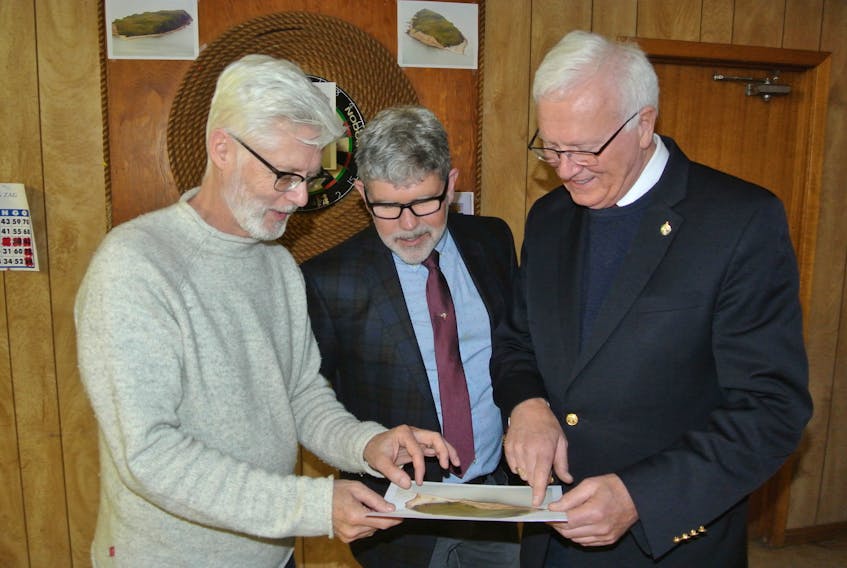ADVOCATE HARBOUR, N.S. — Garry Donaldson has been enchanted with Isle Haute since he was a teen.
Now the manager of migratory birds and habitat for the Canadian Wildlife Service, he couldn’t be happier that his department, Environment and Climate Change Canada, will protect the island in the Bay of Fundy just eight kilometres off Advocate Harbour.
The island will become the 12th National Wildlife Area in Atlantic Canada and the 56th in Canada.
“When I think back to the five years I lived back in Greenwood that’s one of the things that stuck out in my memory, walking along the Fundy coastline and looking out across to the island and wondering what was there,” Donaldson said Tuesday.
While there’s still some work to be done, Environment and Climate Change Canada will soon take possession of the island from the Canadian Coast Guard.
“When you look at where my life went between those hikes as a teenager and what we’re doing today makes it all the more special,” he said.
The island, that is three kilometres long and 400 metres wide, was used by the Mi’kmaq to make stone tools for several thousand years before the arrival of the first Europeans, while in 1604 Samuel de Champlain gave it the Isle Haute, or high island, for its towering 100-metre tall cliffs.
For Cumberland-Colchester MP Bill Casey, the announcement marks the conclusion of 18 years of work dating back to 2001 when he saw an ad offering the island for sale in the Canadian Geographic magazine.
“I’m so grateful for all the pieces to come together. I know things with government take time and I don’t mind that it took 18 years, as long as it happens,” Casey said. “It’s an asset we can build on in Cumberland and Colchester counties and it’s going to be a great enhancement for the proposed Aspiring Cliffs of Fundy Geopark. At the end, I’m just glad it has been saved.”

Casey said the waiting period included four governments and four prime ministers, some of whom were more interested than others. He said all that changed when he first showed aerial photos of Isle Haute to Environment and Climate Change Minister Catherine McKenna.
“She got behind this from Day 1. Her enthusiasm was incredible. The minute she saw the photos she told me ‘we have got to do this, it has to be done.’ Even with her enthusiasm and support, it still took four years to get it done.”
The timing is also perfect since officials from UNESCO will be in the area within the next several months doing an evaluation of the geopark project.
“Having the Government of Canada saying this is a protected national wilderness area will do a lot to assist that application,” said Casey, who credited the community as the Guardians of Isle Haute for its support of protecting the island. “You cannot go to the island and not be moved by the majesty of the cliffs and the wildlife. The last time I was there, we just putted around the island and there must have been a hundred seals that followed us all the way around the island to see what we were doing. It is just magic.”
Dr. John Calder, Nova Scotia’s senior geologist, has been interested in the island not only for its geological story but also because of its natural beauty.
“It’s an incredible place and it’s so wild out in the bay. It has had human interaction for who knows how long but it still survives as this natural beautiful part of the earth. That’s what’s really striking to me,” said Calder, who is also active with effort to create the geopark. “It really has its origins in the origins of the modern world. When the massive continent of Pangea started to split apart 200 million years ago that’s when Isle Haute was formed. That underscores the deep primeval history of that place and it’s really special.”
The island is also important to the Indigenous community. Roger Hunka of the Maritime Aboriginal Peoples Council said no one knows how far back Indigenous habitation goes.
He said Indigenous people’s interaction with the island could be as old, or older than Debert, which an archeologist says habitation goes back as far as 11,000 years.
“It’s a significant island in that it represents a continuum from the Mi’kmaq people, who used that island and lived on that island, to Samuel de Champlain and the French connection and the name Isle Haute and then with the English,” Hunka said. “It’s great the community is trying to protect it and preserve it. It’s an excellent example of biodiversity and it’s also a unifying island in that it’s bringing everyone together to protect its biodiversity.”
RELATED









